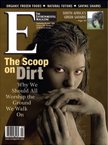
Part 2 of our "Outdoor Living" trends article is in today's
Washington Examiner print edition on page R4
or go
online and scroll to page 60.
Which got me thinking about the opposite of outdoor living -- the coming indoors of outdoor creatures. Yeah, I'd be pretty perturbed if a family of squirrels was running around inside my walls or a raccoon moved into my attic. But can you really blame them? It's cold, wet, and windy out there today - just plain yucky. Hey, it's only fair as we move into our outdoor living rooms, that they get to experience a bit of the indoor amenities may be not be using. The movie
Over The Hedge this year really illustrated that point. You expand your territory and they will adapt into yours.
This coyote-in-the-city pic is from the
National Wildlife magazine. I just adore these guys and their clever ways. (I'd rather sit next to this creature on the metro, than most of the humans that plop down next to me. At least he keeps to his portion of the seat!) Their article photo examples are from Central Park in NYC. My neighbors in Rock Creek Park and along the beltway have spotted coyotes running around here as well. So they are just a few blocks from me in all directions. It is only a matter of time before I spot one drinking from my pond. If they eat the rats from nearby restaurant trash dumpsters, I welcome them! If they did anything to keep the deer away, it'd be great as well - though they have not proven a real deterrent so far to any deer-afflicted neighborhoods. I do fear for the small pets and hope folks have the brains to not have their cats and small dogs out at night around these predators.
Interesting point in this
NWF piece was that coyotes are native to these parts and that they do belong here in the food chain. The frightening part to me was that people are actively feeding them. Live and let live is one thing, but actually trying to attract them is just ridiculous. While they are cute, they are not Disney characters nor are they your friends.
10/12 UpdateJust got this from the THE MARYLAND-NATIONAL CAPITAL PARK AND PLANNING COMMISSION - MONTGOMERY COUNTY DEPARTMENT OF PARKS
PRESS RELEASEINCREASED COYOTE SIGHTINGS REPORTED IN MONTGOMERY COUNTY PARKS AND AROUND THE COUNTY
SILVER SPRING, MD - Natural Resources staff in the Montgomery County Department of Parks report coyotes are being seen regularly throughout the county. First reported in the 1980s, their population remained fairly low through the 1990s then rose in the last five years. Reports of coyote sightings are averaging one a month. Before five years ago coyote sightings reports were received once or none a year.
Suburban environments, which include landscaped yards, parks and agricultural lands provide the ideal habitat for many wildlife species, particularly the adaptable coyote. Coyotes that become too comfortable around humans can quickly become pests.
Here are some things to do and not do in order to keep coyotes wild and to minimize conflicts.
· Never feed coyotes or other wildlife (with the exception of birds) · Don’t leave bowls of pet food or water outside at night · Keep garbage in sturdy containers with tight fitting lids · Keep compost in enclosed bins instead of exposed piles · Keep bird feeders out of reach and don’t let seeds accumulate on the ground · Close off crawl spaces under porches and sheds where coyotes could rest and den · Supervise small children at all times · Keep cats indoors · Keep dogs indoors at night · Watch small dogs while outside even during daylight hours · Always walk your dogs on a leash. · Spay or neuter your dogs · Don’t tolerate coyotes around your yard - chase them off by yelling, throwing objects toward the animal (not at them)
Above all, keep coyotes wild and fearful of humans.
Generally coyotes are shy and will run as soon as they see or smell a human. In the unusual event that a coyote seems unafraid or even bold, chase it off by waiving your hands over your head, to appear as large as possible, and yelling in a deep voice. If need be, throw sticks or rocks. Most animals will be easily frightened off.
Report unusual behavior to authorities. For Montgomery County Parkland call 301/949-4149 or 301/949-2909. For other areas call the Department of Natural Resources Emergency number 410/260-8888.
For more information on coyotes in Montgomery County visit www.mc-mncppc.org/environment <
http://www.mc-mncppc.org/environment>.
I just want to add that I tried that rock throwing and shaking a stick thing last year with a big, fat raccoon in my yard, it does NOT work. He basically gave me a "come on, you and I both know you are not going to actually hit me" look. He called my bluff and I caved.
 Gardeners across the land, beware the lure of Mother Nature and her Green Man - lest you be turned into one yourself! Resist the urge to garden every day and night! Cast off the lust for flowers and foliage! Repent your fertilizing ways! You have been warned...
Gardeners across the land, beware the lure of Mother Nature and her Green Man - lest you be turned into one yourself! Resist the urge to garden every day and night! Cast off the lust for flowers and foliage! Repent your fertilizing ways! You have been warned...












